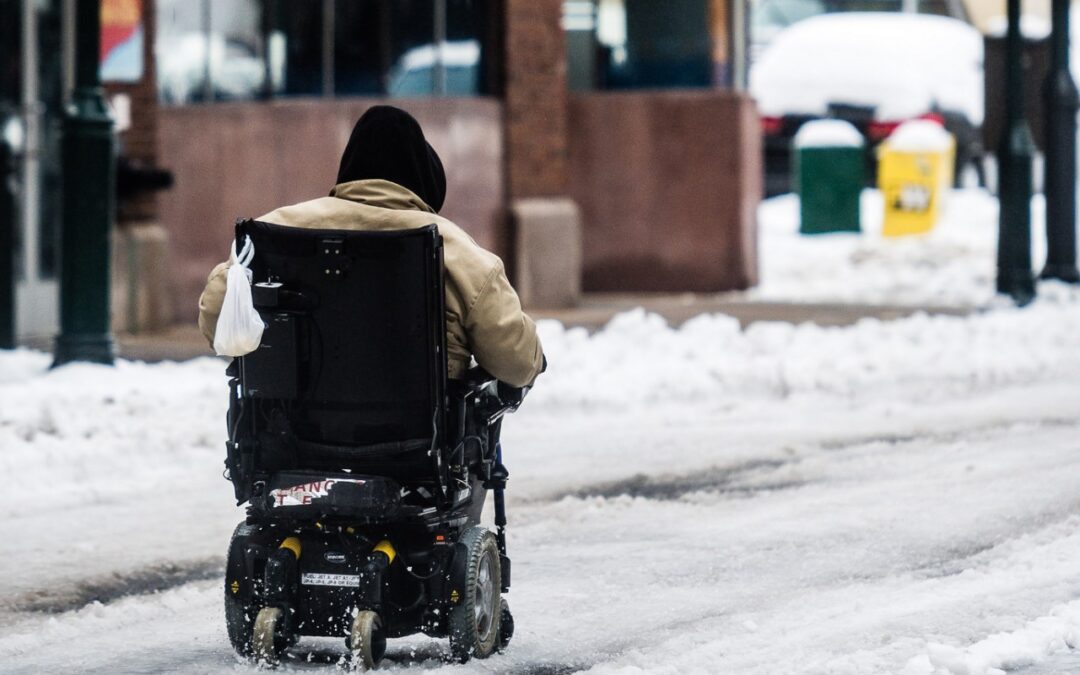So, here in New Brunswick winter has come on fierce and early leaving many wheelchair users (like me) bracing themselves for another round of battle against the elements. Although my typical methods of transport are my manual chair and my van, I know many of my friends and our Tango clients rely on the use of powerchairs and scooters to get around. These electronic mobility devices can work great, but there are some things you need to be mindful of to make sure they keep working and are reliable all winter long. I have polled a few of our equipment specialists and technicians to come up with a list of reminders or tips to help you transition into the winter and avoid the frustration that can come with your equipment not working as expected.
1- Batteries don’t like the cold! If you are storing your equipment outside or in an unheated shed or room, make sure to have your battery properly charged, or bring the battery inside. A discharged battery stored in the cold might lose its ability to charge completely, leaving you without your wheels when you need them, and an expensive replacement bill. If you noticed your battery holding less of a charge in the summer and fall, this will only get worse when the cold temperatures hit. Be sure to adjust your travel in case you get less range out of your charge, or invest in that new battery you have been meaning to get.
2- Electronics and rain/snow don’t always mix very well. Although most electronic mobility devices are designed to be used outside, sometimes, a heavy rain or wet snow can result in water getting where it shouldn’t. The most sensitive part of a power wheelchair or scooter tends to be the control module, but luckily these can be covered without too much trouble. A common trick is to always carry a garbage bag or a inexpensive poncho on your chair in case you end up needing extra protection. If you are an hour from home in a storm you will be happy to have it.
3- Be careful when cleaning your equipment – Yes it is a good idea to get the winter grime and road salt off your chair, but using pressure washers or inundating electronic components can cause water to go where it shouldn’t. A sponge and bucket of soapy water is your best bet for cleaning.
4- Carry a cell phone and be ready to ask for help – No matter how experienced you are, if you venture out before all the snow is cleaned up, there is a chance you will get stuck. Before making a trip, let people know where you are going, when you will be home, and carry a cell phone. If making an attempt at venturing through a drift or sketchy section of unplowed sidewalk, have a look around to see if there might be someone to offer a push if needed. People can be very helpful when in a pinch, but if nobody is around you could be stuck out in the cold (literally) until a rescue call is answered.
5- Check your tires – If you are the type to head out in all conditions, then a more aggressive tread pattern on your drive wheels could help you stay moving despite the conditions. Similarly, if your existing tires are worn and now lack the tread they came with, this might be a good time of year to get a new pair installed.
6- Call ahead – When venturing out after a storm it can be worth a quick call to find out if your destination has been shoveled out.
7- Don’t assume traffic can see you – In the winter the days are short, the roads get narrow, and if you add a snowfall, visibility can be very poor. Often times, the lack of snow removal from sidewalks forces us mobility device users on the streets with traffic. Make sure you have reflectors, lights, and flags to help to make sure you are seen.
Although these might be common sense to many of you, it doesn’t hurt to get a reminder to help you manage the winter season with more ease.
Matt Kinnie – Tango’s resident wheelchair user


Recent Comments